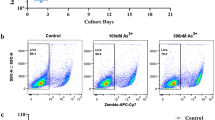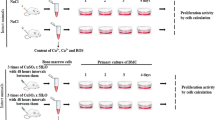Abstract
Lead is known to induce hematological disturbances resulting from abnormalities in cell differentiation and hemoglobin synthesis during hematopoiesis. The aim of the present work was to study human erythropoiesisin vitro in the presence of lead. Human erythroblastic progenitors, burst-forming units–erythroid (BFU-E), were exposed to lead acetate at increasing concentrations during 14 days of culture. Hematotoxicity was evaluatedin vitro according to proliferation and differentiation of cell colonies arising from BFU-E development. The ability of cells to synthesize proteins, porphyrins, and hemoglobin was measured by spectrophotometric tests and by high-pressure liquid chromatography (HPLC). Results showed that in the presence of 10–3 mol/L lead acetate, no hemoglobinized cells were observed in culture and no fluorescent porphyrins were detected in cells. Up to 10–3 mol/L, lead acetate is not cytotoxic, i.e., it does not induce cell destruction. The present work demonstrates that lead acetate interferes with the porphyrin synthesis of human erythroblastic progenitors in vitro. The decrease of porphyrin content with 10–5 mol/L lead acetate suggest that δ-aminolevulinic acid dehydratase can be inhibited by lead acetate duringin vitro erythropoiesis. In vivo erythropoiesis occurs in the bone marrow. As about 95% of the body burden of lead in adults is located in the bones with a biological half-life of some years, the concentration of lead acetate found to block porphyrin synthesis in vitro has to be compared with in situ bone marrow lead concentrations.
Similar content being viewed by others
References
Barry PSI. Concentrations of lead in the tissues of children. Br J Indust Med. 1981;38:61-71.
Boorman GA, Luster MI, Dean JH, Campbell ML. Assessment of myelotoxicity caused by environmental chemicals. Environ Health Perspect. 1982;43:129-35.
Bottomley SS, Muller-Eberhard U. Pathophysiology of heme synthesis. In: Muller-Eberhard U, ed. The biology of heme. I. 1988;XXV:282-302.
Bowers MA, Aicher LD, Davis HA, Woods JS. Quantitative determination of porphyrins in rat and human urine and evaluation of urinary porphyrin profiles during mercury and lead exposure. J Lab Clin Med. 1992;120:272-81.
Bradford MM. A rapid and sensitive method for quantification of microgram quantities of protein utilizing the principle of protein-dye binding. Anal Biochem. 1976;72:248-54.
Dresner DL, Ibrahim NG, Mascarenhas BR, Levere RD. Modulation of bone marrow heme and protein synthesis by trace elements. Environ Res. 1982;28:55-66.
Granick JL, Sassa S, Granick S, Levere RD, Kappas A. Studies on lead poisoning. II. Correlation between the ratio of activated to inactived aminolevulinic acid deshydratase of whole blood and the blood level. Biochem Med. 1973;8:149-59.
Hernandez E, Gutierrez-Ruiz MC, Garcia Vargas G. Effect of acute lead treatment on coproporphyrinogen oxidase activity in HepG2 cells. Toxicology. 1998;126:163-71.
Ibrahim NG, Lutton JD, Levere RD. The role of hacm biosynthetic and degradative enzymes in erythroid colony development: the effect of haemin. Br J Haematol. 1982;50:17-28.
Lautraite S, Parent-Massin D, Rio B, Hoellinger H. Comparison of toxicity induced by T-2 toxin on human and rat granulo-monocytic progenitors with an in vitro model. Hum Exp Toxicol. 1995;14:672-8.
Lutton JD, Ibraham NG, Friedland M, Levere RD. The toxic effects of heavy metals on rat bone marrow in vitro erythropoiesis: protective role of hemin and zinc. Environ Res. 1984;35:97-103.
Meredith PA, Moore MR, Campbell BC, Thompson GG, Goldberg A. Delta-aminolevulinic acid metabolism in normal and lead exposed humans. Toxicology. 1978;9:1-9.
Naughton BA, Sibanda D, Azar L, San Roman J. Differential effects of drugs upon hematopoiesis can be assessed in long-term bone marrow cultures established on nylon screens. Proc Soc Exp Biol Med. 1992;199:481-90.
Parchment RE, Huang M, Erickson-Miller CL. Roles for in vitro myelotoxicity tests in preclinical drug development and clinical trial planning. Toxicol Pathol. 1993;21:241-50.
Parent-Massin D, Thouvenot D. In vitro study of pesticide hematotoxicity in human and rat progenitors. J Pharmacol Toxicol Methods. 1993;30:203-7.
Parent-Massin D, Sensébé L, Léglise MC, et al. Relevance of in vitro studies in drug-induced agranulocytosis. Report of 14 cases. Drug Safety. 1993;9:461-9.
Parent-Massin D, Pesando D, De Lecluzes C, Fournier V, Ramade F, Lome, R. Evaluation of human toxicological risk due to Caulerpenyne. J Toxicol Environ Health. 1996;47:47-59.
Quintanilla-Vega B, Hernandez A, Mendoza-Figueroa T. Reduction in porphyrin excretion as a sensitive indicator of lead toxicity in primary cultures of adult rat hepatocytes. Toxicology In Vitro. 1996;10:675-83.
Rabinowitz MB. Kinetic analysis of lead metabolism in healthy human. J Clin Invest. 1976;58:260-70.
Rio B, Parent-Massin D. Improvement of erythroblastic progenitor culture for toxicological investigations. Toxicol Methods. 1997;7:363-80.
Rio B, Parent-Massin D, Lautraite S, Hoellinger H. Effects of a diphenyl-ether herbicide, oxyfluorfen, on human BFU-E development and haemoglobin synthesis. Hum Exp Toxicol. 1997;16:115-22.
Sassa S, Granick JL, Granick S, Kappas A, Levere RD. Studies in lead poisoning. I. Microanalysis of erythrocyte protoporphyrin levels by spectrofluorimetry in the detection of chronic lead intoxication in subelinical range. Biochem Med. 1973;8:135-48.
Scoble HA, McKeag M, Brown PR, Kavarnos GJ. The rapid determination of erythrocyte porphyrins using reversed-phase high performance liquid chromatography. Clin Chim Acta. 1981;113:253-65.
Timbrell JA. Multi-organ toxicity. In Timbrell, JA, ed. Principles of biochemical toxicology, 2nd edn. London: Taylor & Francis; 1994;369-78.
Van Den Heuvel RL, Leppens H, Schoeters GER. Lead and catechol hematotoxicity in vitro using human and murine hematopoietic progenitor cells. Cell Biol Toxicol. 1999;15:101-10.
Woods JS, Miller HD. Quantitative measurement of porphyrins in biological tissues and evaluation of tissue porphyrins during toxicant exposures, Fundam Appl Toxicol. 1993;21:291-7.
World Health Organization. Air quality guidelines for Europe. European Series no. 23. Lead. Geneva: WHO; 1987:242-61.
Author information
Authors and Affiliations
Rights and permissions
About this article
Cite this article
Rio, B., Froquet, R. & Parent-Massin, D. In vitro effect of lead acetate on human erythropoietic progenitors. Cell Biol Toxicol 17, 41–50 (2001). https://doi.org/10.1023/A:1010955114764
Issue Date:
DOI: https://doi.org/10.1023/A:1010955114764




